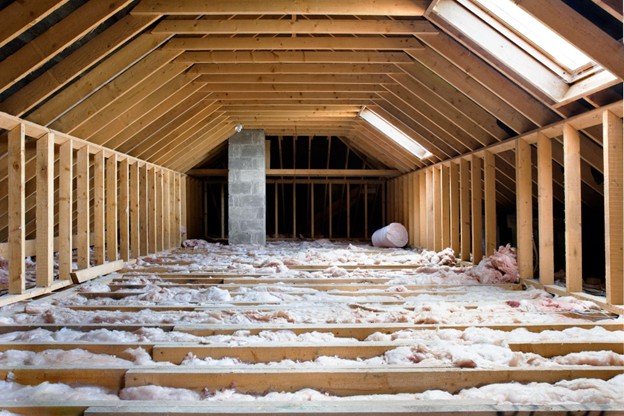Why Does Attic Rain Happen?
Canadian homeowners dealing with a long, cold winter also have to deal with attic rain issues. Attic rain is not from a leaky roof; it’s actually the result of a unique set of conditions that cause condensation and water to form and collect inside your attic. Attic rain occurs when warm, humid air trapped in the attic freezes to the roof deck, particularly during cold weather.
Having an understanding of the basics of attic rain can help prevent serious damage and moisture-related problems around your home. If you’re concerned about this phenomenon, it’s worth speaking to attic rain specialists in Calgary who can assess your attic and provide tailored solutions.
Table of Contents
● What Is Attic Rain?
o The Basic Science Behind It
o Why It’s Different from a Roof Leak
● What Causes Attic Rain in Canadian Homes?
o Temperature Fluctuations
o Poor Ventilation and Insulation
o Indoor Humidity and Air Leakage
● Signs That You Might Have Attic Rain
o Visual Clues in the Attic
o How It Affects Living Spaces
● What Kind of Damage Can Attic Rain Cause?
o Structural Damage
o Mold Growth and Indoor Air Quality
● How to Prevent Attic Rain
o Improve Ventilation and Insulation
o Manage Indoor Moisture
o Professional Assessment and Maintenance
● Don’t Let Attic Rain Catch You Off Guard
What Is Attic Rain?
Attic rain is a result of indoor air rising into the attic. It freezes cold surfaces during the winter, then it melts and causes water damage. Let’s look deeper into the science behind it.
The Basic Science Behind It
Attic rain occurs when warm, humid air escapes into the attic during the winter months. It condenses on the underside of your roof deck. Thermal bridging continues the process by allowing it to transfer through building materials. This creates cold spots and makes condensation more likely to occur. Moisture builds up over time and eventually freezes, so when the weather warms up and frost melts, you’ll end up with attic rain.
Why It’s Different from a Roof Leak
Unlike a roof leak caused by external damage or wear, attic rain is an internal issue caused by air movement, insulation gaps, and excess moisture. This is why it often surprises homeowners—there’s no obvious damage to the roof, yet water is seeping into insulation, wood, or even drywall.
What Causes Attic Rain in Canadian Homes?
Here’s a brief look at some of the causes of attic rain in Canadian homes.
Temperature Fluctuations and Cold Snaps
Canada’s climate plays a huge role in forming attic rain. In cities like Calgary, where winter temperatures can vary dramatically every day, the conditions for attic rain are perfect. Really cold nights followed by mild afternoons lead to a cycle of thawing and freezing in the attic.
Poor Ventilation and Insulation
Poor ventilation means the attic doesn’t “breathe”. It’s one of the biggest causes of attic rain. It means that warm air gets trapped and cannot escape. Combine that with inadequate insulation, and moist air reaches cold surfaces in the attic where the condensation freezes.
Indoor Humidity and Air Leakage
Daily activities like showering, cooking, and even breathing generate heat and humidity. If you’re hearing weird sounds from the bathroom fan or seeing water stains on the ceiling, you might have an attic rain problem. When moist air finds its way into the attic through cracks, gaps, or poorly sealed fixtures, it can cause buildup that leads to attic rain. The best thing you can do to prevent it is to control indoor humidity.
Signs That You Might Have Attic Rain
Here are just a few telltale signs that you might have an attic rain issue.
Visual Clues in the Attic
Frost buildup on the underside of your roof deck, water staining, sagging insulation, or even mould are all clear indications of attic rain.
How It Affects Living Spaces
Sometimes, the signs of attic rain show up in your living spaces before you even look at the attic. If you find water stains on the ceiling, damp patches on your walls, or peeling paint, it might be caused by melted frost that’s coming down from above.
What Kind of Damage Can Attic Rain Cause?
Left untreated, attic rain can cause all kinds of damage to your home. The best thing you can do is be as proactive as possible. Consider the different potential outcomes.
Structural Damage
Water can be very destructive to your home. Attic rain can affect wood beams, lead to rotting structural components, and degrade insulation. If you continue to leave it untreated, it can damage your roof.
Mold Growth and Indoor Air Quality
Moisture from attic rain can lead to mould growing throughout your house. This not only damages building materials, but it can also be hazardous to your health and the quality of the air you breathe indoors.
Repairing Attic Rain Damage
Repairing attic rain damage requires immediate attention to prevent further damage and potential health hazards. Here are the steps to take:
Immediate Steps to Take
- Assess the damage: Thoroughly inspect your attic and ceiling for signs of water damage. Look for buckled ceiling tiles, musty odours, and water stains.
- Contain the damage: Tarps or plastic sheets can help prevent further water damage by protecting your home’s interior and containing moisture.
- Dry the area: Fans and dehumidifiers can dry out affected areas. Using them wisely can help prevent serious damage.
- Remove damaged materials: Damaged insulation, drywall, or roofing materials need to be carefully removed. This is essential for preventing ongoing damage.
Long-term Repair Solutions
- Inspect and repair roof vents: Make sure roof vents are working properly. If they are not, you should definitely replace them to avoid issues.
- Improve attic ventilation: Installing additional vents or a more efficient ventilation system is always a good call. It helps prevent moisture buildup.
- Upgrade attic insulation: Proper insulation helps prevent heat loss and reduces the risk of moist air condensing in the cold. It’s a good investment.
- Seal air leaks: Check pot lights, vents, and attic hatches for air leaks. Properly sealed areas of the home prevent the likelihood of attic rain.
How to Prevent Attic Rain
Preventing attic rain requires a combination of solutions that work together to control moisture, seal air leaks, and maintain healthy airflow.
Improve Ventilation and Insulation
Proper attic ventilation regulates temperatures and helps to expel moist air before it condenses.
Soffit vents, ridge vents, and baffles should all be evaluated for optimal airflow. At the same time, improving insulation—particularly in areas where it may be sparse or compressed—helps reduce heat transfer and prevent warm air from reaching cold surfaces.
Manage Indoor Moisture
Reducing humidity inside the home can be done with exhaust fans and dehumidifiers in the bathroom and the kitchen. Ceilings and any air leaks between the attic and living spaces, like plumbing vents, pot lights, or attic hatches, also help limit moisture movement.
Professional Assessment and Maintenance
A professional inspection can reveal problems that you are not necessarily going to catch. Moisture meters, airflow analysis tools, and thermal imaging can spot difficulties better than the naked eye. That’s why many homeowners rely on specialists who can combat attic rain effectively.
Attic Rain in Calgary: Unique Challenges
Calgary’s climate presents unique challenges when it comes to attic rain. Here are some considerations:
Climate Considerations
- Cold snaps: Sudden cold temperatures can last for days. Extreme temperature fluctuations create the ideal conditions for attic rain.
- Moist air: Moist air can still become trapped in the attic despite Calgary’s generally dry climate. This trapped moisture can condense on cold surfaces and cause water damage.
- Poor attic ventilation: In some cases, Calgary building codes don’t necessarily require attic ventilation. This means poor airflow is a possibility. Moist air can accumulate and condense in situations like this.
- Roof deck: Frost buildup is a frequent occurrence on roof decks. Lacking proper ventilation equates to frost build-up, and that can lead to potential structural damage and water problems.
Having a sense of these unique challenges means that homeowners in Calgary can take steps to prevent attic rain issues before they start.
Don’t Let Attic Rain Catch You Off Guard
Attic rain isn’t necessarily on every homeowner’s radar, but it should be, especially in Calgary. If you’ve noticed any of the signs of attic rain or moisture buildup, it would be good to have your attic inspected for the potential risks. Moisture, insulation, and improper airflow are all a recipe for costly repairs and possible health hazards.
Preventative measures are always more cost-effective than paying for more extensive repairs after the fact. Protect your home now, improve its energy efficiency, and give yourself peace of mind as the seasons change. For more information on condensation and building science in cold climates, you can check out Natural Resources Canada.





